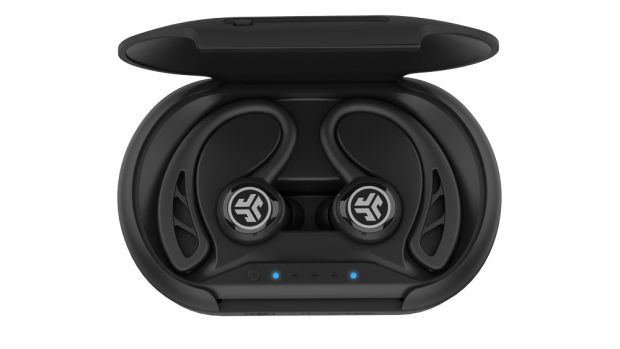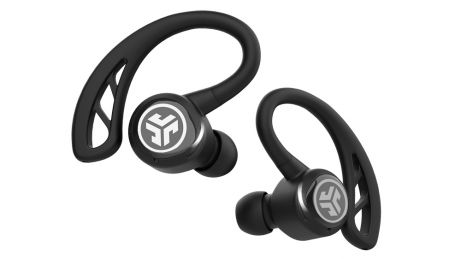You can trust Coach
One of the main downsides of using truly wireless headphones is the battery life. Their small size limits how much juice can be packed in, although the problem is mitigated somewhat by carry cases that double as portable batteries which can recharge the buds.
So when a set of buds manage to last longer than any others, our ears prick up – and the JLab Epic Air Elite are the first I’ve come across that pack six hours of life into the headphones themselves. It’s still short of the eight hours you expect at a minimum with wireless headphones that have a cable connecting the buds, but it’s closing the gap.
Beyond that already impressive six hours, the Epic Air Elite buds’ carry case adds another 32 hours, although to achieve that feat the case is absolutely massive and pretty heavy. Unlike the Apple AirPods case, which adds 19 hours of playback and slips easily in a pocket, the JLab case needs a bag.
The fit is equally stellar. The ear hook ensures the buds will stay put no matter how frenetic your sporting activity is, and you can push the silicone tip (the memory foam options are less durable for exercise) into your ear to block out the world around you. I didn’t find that the buds became uncomfortable even if worn for several hours at a time in the office.
Once you have set up the buds to fit correctly the sound quality is impressive and you can pick between three different preset EQs by tapping on the buds. These are JLab Signature, Balanced and Bass Boost, with the first option set as default and also the one I preferred, though the extra bass was sometimes welcome when working out indoors. Being able to do this on the buds themselves is useful, because with most headphones you have to link them to a partner app to change the EQ.
As well as changing the EQ setting you have all the classic controls available to you through a variety of taps and holds on the outside of the buds. These mostly worked pretty well, but trying to hold a finger against the bud in the right place for just over a second to skip a track while on a run was tough to pull off consistently, and when attempting the double tap to play/pause it often only registered a single tap, which increases the volume. I’m still largely unconvinced that touch panels are better than buttons, though it does allow for a wider range of controls in a small area.
You can also trigger the Be Aware mode by triple-tapping either bud. This will allow more external noise in even if you’ve tucked the tips into your ear, which is useful for running in the city in particular.
See related

There is no quick charge feature on the headphones and it does take a long time to fully charge the case. If you completely deplete the buds they need a couple of hours in the case to get back to 100%, so more planning is required than with most truly wireless headphones, which will usually eke 45 to 60 minutes of playback out of ten to 15 minutes of charging.
I also found that the Bluetooth connection wasn’t infallible, even though either of the headphones can connect to another device – usually with wireless buds there is one that always connects to the source which then links to the other bud. I never had a long drop-out, but usually one headphone would disconnect near the start of a run, then quickly link to my phone again. This was with my phone in a running belt, so it might not be a problem with an armband.
The small Bluetooth problem and slow charging aside, there’s little to dislike about the JLab Epic Air Elites, but you might begrudge the bag space required to haul the case with you (though you can use it to charge your phone and other devices along with the headphones). The secure fit and outstanding battery life make them ideal for long sporting activities, and they sound good enough to use when not exercising as well.
Buy from Argos | £149.99

Nick Harris-Fry is a journalist who has been covering health and fitness since 2015. Nick is an avid runner, covering 70-110km a week, which gives him ample opportunity to test a wide range of running shoes and running gear. He is also the chief tester for fitness trackers and running watches, treadmills and exercise bikes, and workout headphones.

